Here are the essential concepts you must grasp in order to answer the question correctly.
Significant Figures
Significant figures are the digits in a number that contribute to its precision. This includes all non-zero digits, any zeros between significant digits, and trailing zeros in the decimal portion. Understanding significant figures is crucial for accurately reporting measurements and calculations in scientific contexts.
Recommended video:
Significant Figures Example
Leading Zeros
Leading zeros are the zeros that precede all non-zero digits in a number. They are not considered significant because they do not affect the value of the number. For example, in the number 0.000312, the leading zeros do not count towards the significant figures, which are only the '312'.
Recommended video:
Trailing Zeros
Trailing zeros are the zeros that follow non-zero digits in a number. Their significance depends on the presence of a decimal point. For instance, in the number 312,000, the trailing zeros are ambiguous without a decimal point, while in 2000, they are not considered significant unless specified otherwise (e.g., 2000. has four significant figures).
Recommended video:



